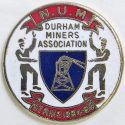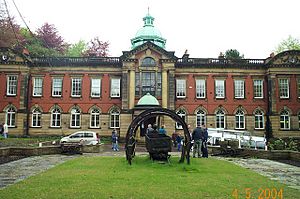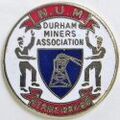Durham Miners' Association facts for kids
 |
|
| Founded | 1869 |
|---|---|
| Dissolved | 2018 |
| Headquarters | Redhills, Durham |
| Location | |
|
Members
|
105,612 (1907) |
|
Key people
|
William Crawford (General Secretary and President), John Wilson (General Secretary and Treasurer), W. P. Richardson (General Secretary), Peter Lee (General Secretary), John Swan (General Secretary), Sam Watson (General Secretary and Treasurer), William House (President), James Robson (President), John Johnson (Treasurer) |
|
Parent organization
|
MNU (1869–1898) MFGB (1892–1893; 1908–1944) NUM (1945–2018) |

The Durham Miners' Association (DMA) was a special group, like a club, for coal miners in the United Kingdom. It was a trade union, which means it worked to get fair pay, better working conditions, and more rights for its members. The DMA was very important in the history of mining in the Durham area.
Contents
History of the Durham Miners' Association
The Durham Miners' Association started in 1869. At first, about 4,000 miners joined, but this number soon dropped. In 1870, a man named William Crawford became the union's president. He worked hard to get more miners to join. Soon, the DMA became the biggest miners' union in the UK.
Early Wins for Miners
The union quickly had some big successes. In 1872, they helped get rid of something called the "Yearly Bond." This was an old rule that forced miners to work for one boss for a whole year, even if they were treated badly. Getting rid of it was a huge win for the miners' freedom.
In 1874, a short strike (when workers stop working to demand changes) helped them agree on wages (how much they got paid) across the whole county. Later, in 1890, the DMA helped miners in Durham be the first in the country to get a standard seven-hour workday. This meant less time spent underground in dangerous conditions.
However, not every strike was successful. In 1879, a longer strike did not stop their wages from being cut. Also, in 1892, a big strike happened because bosses wanted to cut wages by 15%. The strike ended with miners having to accept a 10% pay cut.
Joining Other Unions
In its early days, the DMA was part of a bigger group called the Miners' National Union. The DMA also supported "Lib-Lab" candidates. These were politicians who were often miners themselves or came from working-class backgrounds. They worked with the Liberal Party to represent miners in Parliament. Both William Crawford and John Wilson from the DMA became Members of Parliament.
The DMA joined the Miners' Federation of Great Britain (MFGB) in 1892. But they were kicked out the next year because they refused to join a big national strike. They tried to join again in 1897, but they only wanted to agree on wage issues, which wasn't allowed. The Durham union also disagreed with the MFGB about the "Eight Hours Bill," which aimed to make an eight-hour workday law. The DMA thought it was better to have a seven-hour day, which they had already achieved.
Finally, in 1908, after the Eight Hours Bill became law, the DMA officially joined the MFGB. By 1900, the DMA had grown a lot, with over 80,000 members.
Working Together and Later Years
While the DMA represented most miners in County Durham, some special workers had their own unions. These included the Durham County Colliery Enginemen's Association (for engine drivers), the Durham Colliery Mechanics' Association (for mechanics), and the Durham Cokemen's Association (for workers who made coke). These four unions worked together in a group called the Durham County Mining Federation Board. The secretary of this board was always the secretary of the DMA.
In 1945, the DMA became part of the National Union of Mineworkers (NUM). It was known as the Durham Area, or later the North East Area of the NUM, but many people still called it by its old name. The Durham Miners' Association continued its work until it officially closed down in 2018.
Important Leaders of the DMA
Many dedicated people led the Durham Miners' Association over the years. These leaders worked hard to improve the lives of miners and their families.
General Secretaries
The General Secretary was a very important role, like the main manager of the union.
- William Crawford (1871)
- John Wilson (1896)
- Peter Lee (1930)
- Sam Watson (1945)
Presidents
The President was another key leader, often the public face of the union.
- William Crawford (1870)
- William House (1900)
- James Robson (1917)
Treasurers
The Treasurer was in charge of the union's money.
- John Wilson (1882)
- John Johnson (1890)
- Sam Watson (1932)
Images for kids


